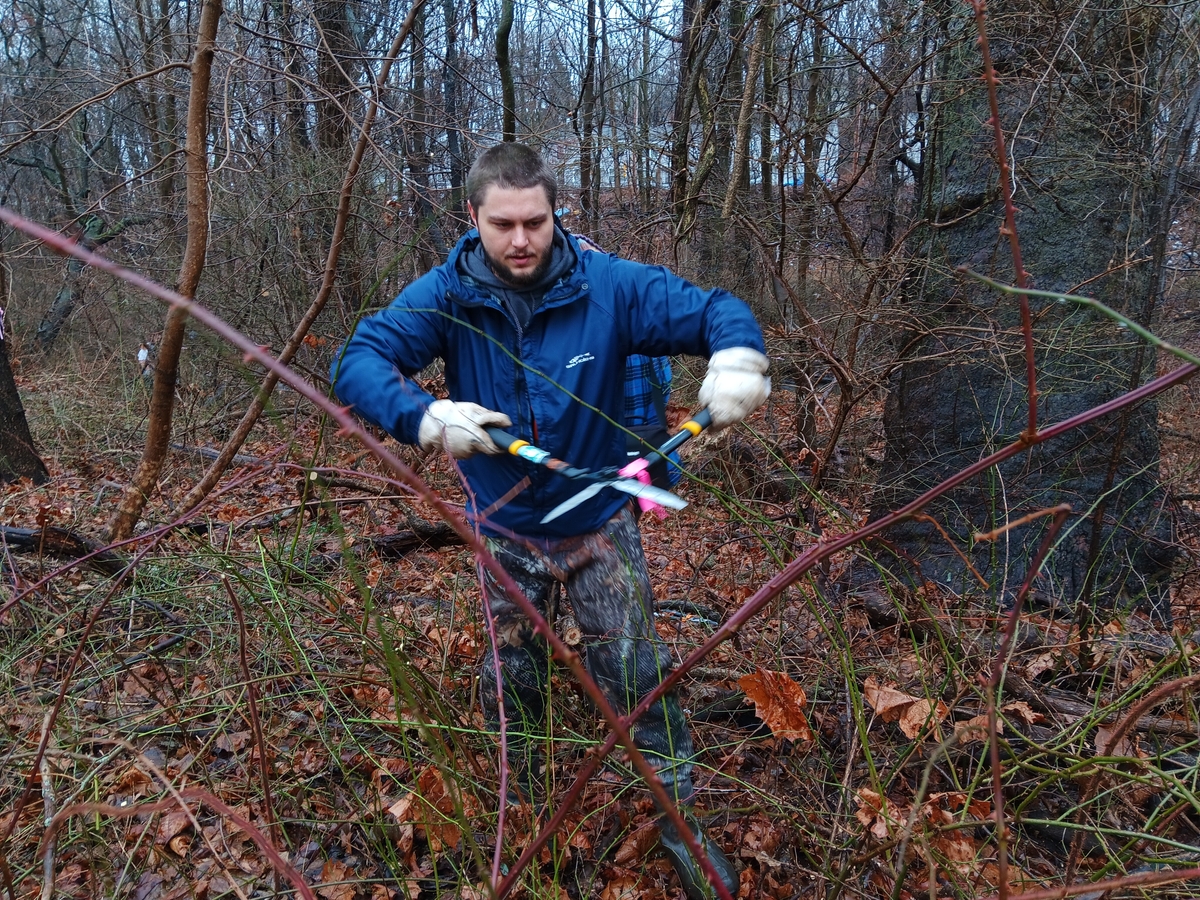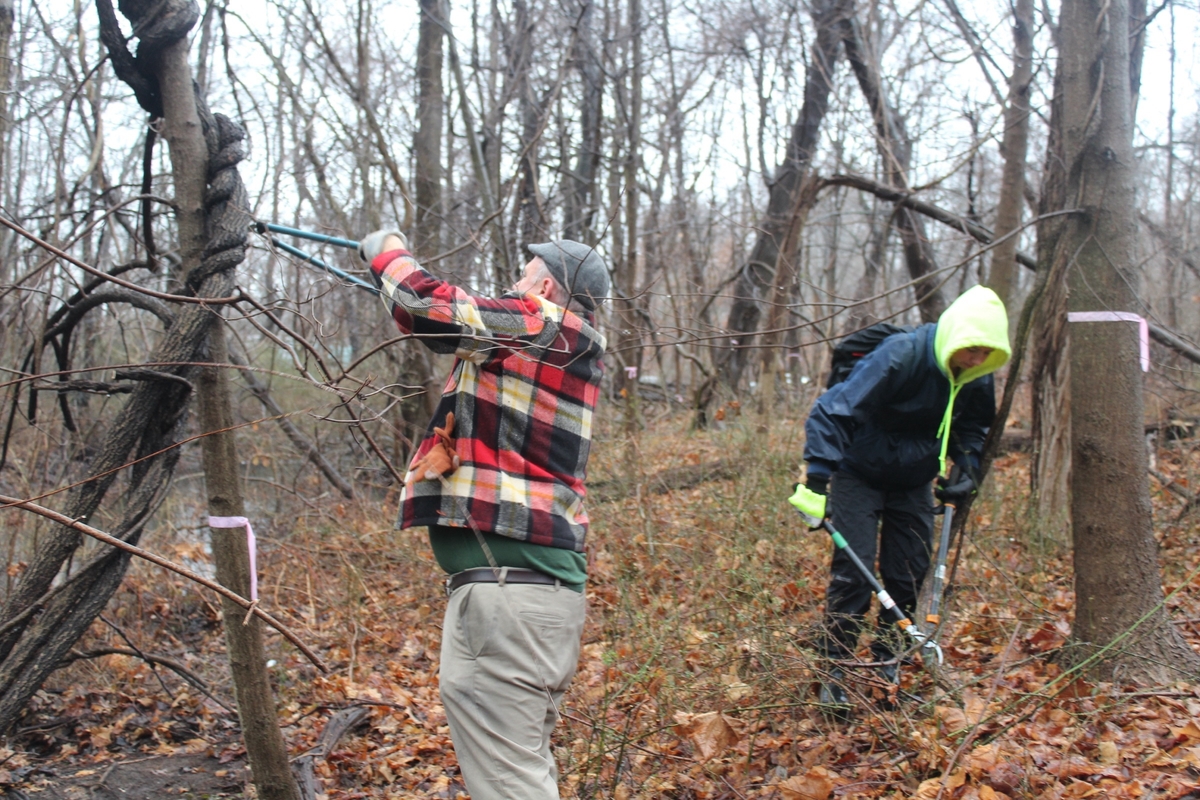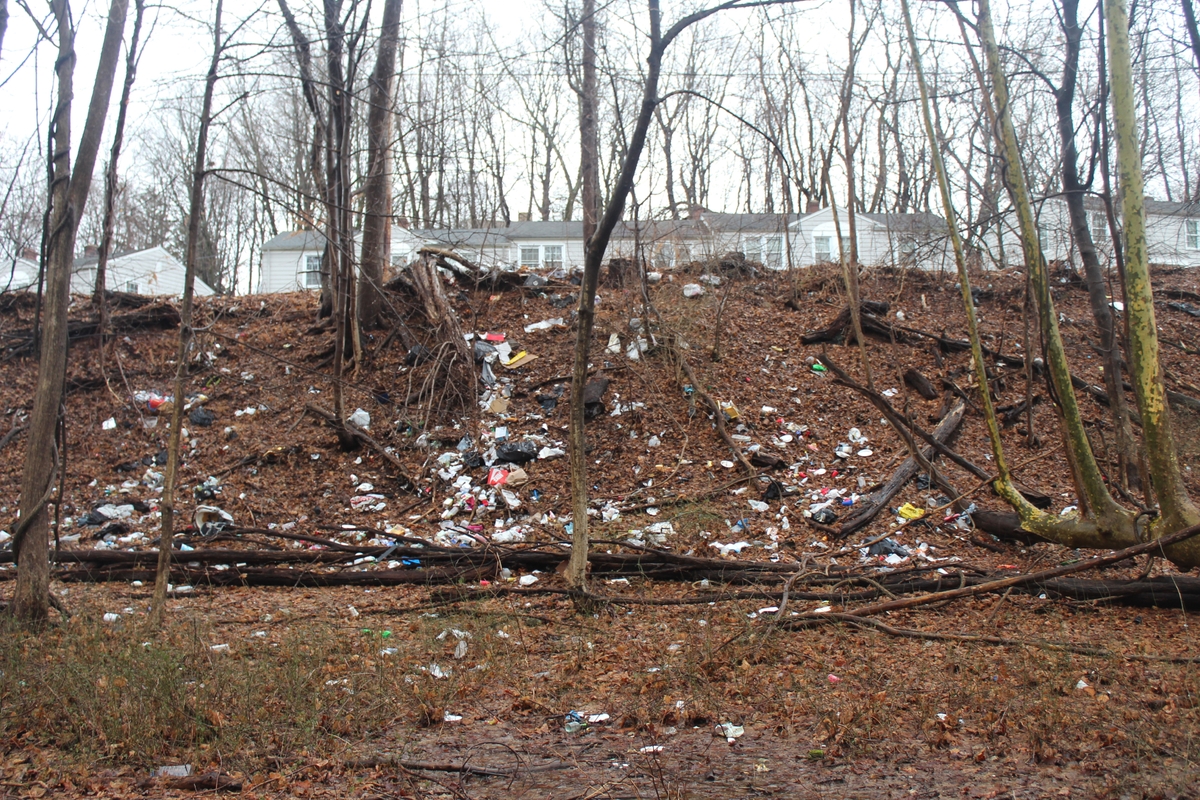
Allan Appel Photo
Anthropology major Chris Kowalski (above) and Aaron Goode (below) de-vine by Beaver Brook.

Brian Slattery Photo
Clip high, clip low, create a window. Also don’t be a Tarzan and pull on those cut vines lest you disturb insect habitats or the birds high in the trees above.
Those were among the illuminating arboricultural tips offered for some serious de-vining of New Haven’s invasive-threatened native oaks, maples, sycamores, and hackberry trees growing on a beautiful but under-loved patch of city-owned forested greenspace.

Allan Appel Photo
Southern students Kahiona Senior and Joela Depass flank Derek Faulkner and Chris Ozyck at community clean-up.
The de-vining took place at the broad triangle of public park land adjacent to Beaver Brook, a tributary of the West River, at the intersection of Fitch and Crescent streets across from the entryway to Southern Connecticut State University’s main campus.
Organized by Derek Faulkner of SCSU’s Office of Sustainability, about a dozen students arrived over the course of two hours Friday morning. They received gloves, saws, loppers, and, most importantly, instructions from New Haven De-Viner-in-Chief Chris Ozyck of Yale University’s Urban Resources Initiative.
“If the vine is sticking to the tree, leave it alone,” Ozyck cautioned because such vines, like the much maligned poison ivy and Virginia creeper, “play nice”: They don’t strangle and kill.
“Virginia creeper is perfect for moths, which leave larvae, which in turn is food for birds, and is a special favorite of cardinals. So if you want more cardinals, you want more Virginia creeper,” Ozyck informed the group.
But you must be merciless with other invasives like bittersweet, the burning bush, tree of heaven, and grapevine, Ozyck added. That does not mean yanking off the vines. It means de-vining through what Ozyck termed low-energy forest “editing.”
“All this is preventative maintenance, stewardship,” Ozyck added. It’s low-energy output: You don’t use chain saws, fossil fuels, or even human energy to haul away the debris cut.
The vines lie on the soil when they drop there, even stir it up a bit. That creates a little nitrogen release that in turn is good for the trees, Ozyck continued in his impassioned explanations for the students and press. Then in a remarkably short period of time, a season or two, the freed trees begin to regenerate from the strangling of vines.
As cars sped by on busy Fitch Street, SCSU students Kahiona Senior and Joela Depas were among the first volunteers to arrive on the rainy morning. They were all in for the de-vining gospel. Donning make-shift ponchos fashioned from contractor garbage bags, they headed out among the brush and thorns.
“It’s our home,” said Joela, who’s an SCSU senior.
“The Lord provided us a planet; the least we can do is care for it,” she added as Ozyck showed her how to cut the bittersweet without yanking above or pulling up roots from below.
That method deprives the vine of nutrients and the ability to seed. So when the students come back in the summer to do another round of lopping, the vine will basically have starved itself. The tree, no longer a victim, will have begun to leaf more, and even begin to straighten and recover.
When the vines drop and just lie there as debris, they suck up a little more carbon as of course the trees do themselves.
Ozyck said that to get the carbon storage benefit of a 100 year-old sycamore smack dab in the middle of the greenspace, “you’d have to plant 150 new trees to make up the value of one old one. These are cooling centers for the city.”
Ozyck said the de-vining currently taking place in parks across the city is “extraordinarily urgent.”
That’s in part what motivated SCSU’s Faulkner to reach out to Ozyck, West River Watershed Coalition, the Friends of Beaver Ponds Park, Friends of Edgewood Park, and the Whalley Edgewood Community Mangaement Team, whose representatives were also among the de-viners Friday morning.
The work of clearing vines will give SCSU students pedestrian access to the beautiful brook. Perhaps tables to sit at are also in the future, Faulkner said.
The effort may also start a trend that will attract professors in the sciences to utilize the cleared area to hold classes in the good weather and conduct research there with students.
In addition to the stewarding of the trees are two related challenges: First, getting rid of the heart-breaking amount of litter and serious garbage (including mattresses, wheelchairs) that mar especially the far side of the site, across the brook on the steep hill side leading up to Diamond Stree. Second, creating a walkable path all along the brook perhaps as far as Beaver Pond itself.
Work will continue on these challenges over the next two Fridays, Feb. 2 and 9, also from 11 a.m. to 1 p.m.. The meet-up location is that corner of Fitch and Crescent, with parking, if you drive, in the lot of the Ethnic Heritage Center off of Fitch Street. Everyone’s welcome to participate. The contact is SCSU Office of Sustainability Program Coordinator Derek Faulkner ([email protected]).

Brian Slattery Photo




Thank you to all the volunteers doing this important work! I hope more people join their efforts in preserving and maintaining our green places and rescuing native habitats from harmful invasive plants.